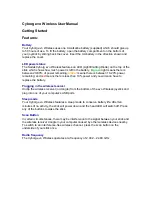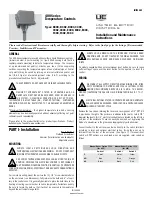
Viewing angle considerations
As display contrast and color are affected by the viewing angle, It is recommended that you
temporarily power up the display, prior to installation, to enable you to best judge which location
provides the optimum viewing angle.
For the viewing angles for your product refer to
p.43 — Technical specification
EMC installation guidelines
Raymarine equipment and accessories conform to the appropriate Electromagnetic Compatibility
(EMC) regulations, to minimize electromagnetic interference between equipment and minimize the
effect such interference could have on the performance of your system
Correct installation is required to ensure that EMC performance is not compromised.
Note:
In areas of extreme EMC interference, some slight interference may be noticed on the
product. Where this occurs the product and the source of the interference should be separated
by a greater distance.
For
optimum
EMC performance we recommend that wherever possible:
• Raymarine equipment and cables connected to it are:
– At least 1 m (3.3 ft) from any equipment transmitting or cables carrying radio signals e.g. VHF
radios, cables and antennas. In the case of SSB radios, the distance should be increased to 2
m (6.6 ft).
– More than 2 m (6.6 ft) from the path of a radar beam. A radar beam can normally be assumed to
spread 20 degrees above and below the radiating element.
• The product is supplied from a separate battery from that used for engine start. This is important
to prevent erratic behavior and data loss which can occur if the engine start does not have a
separate battery.
• Raymarine specified cables are used.
• Cables are not cut or extended, unless doing so is detailed in the installation manual.
Note:
Where constraints on the installation prevent any of the above recommendations
, always ensure
the maximum possible separation between different items of electrical equipment, to provide the
best conditions for EMC performance throughout the installation.
RF interference
Certain third-party external electrical equipment can cause Radio Frequency (RF) interference with
GNSS (GPS), AIS or VHF devices, if the external equipment is not adequately insulated and emits
excessive levels of electromagnetic interference (EMI).
Some common examples of such external equipment include LED lighting (e.g.: navigation lights,
searchlights and floodlights, interior and exterior lights) and terrestrial TV tuners.
To minimize interference from such equipment:
• Keep it as far away from GNSS (GPS), AIS or VHF products and their antennas as possible.
• Ensure that any power cables for external equipment are not entangled with the power or data
cables for these devices.
• Consider fitting one or more high frequency suppression ferrites to the EMI-emitting device. The
ferrite(s) should be rated to be effective in the range 100 MHz to 2.5 GHz, and should be fitted
to the power cable and any other cables exiting the EMI-emitting device, as close as possible to
the position where the cable exits the device.
19
















































